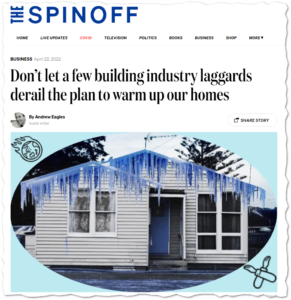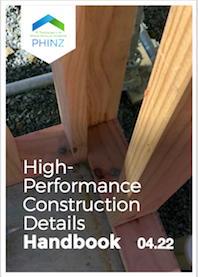Clear, specific and timely actions to reduce schools’ operational and embodied carbon footprint are contained in a recent Ministry of Education (MoE) report, . The recommendations are excellent and they matter because the Ministry manages a huge real estate portfolio and is a major real estate developer: over 16,000 buildings used by over 790,000 students in 2100 state-owned schools/kura The …
QuickSet all set for updated H1 requirements

Here’s a great summary from QuickSet outlining its practical formwork/insulation solutions that fit with the increased H1 requirements. This includes heated slabs. We’re proud to have helped with these developments, including the thermal modeling for their slab systems. The new QuickSet Ultra with base insulation makes this building scientist happy! Also worth noting: the QuickSet standard taper has also improved. …
Scaling up PH trades training

New Zealand needs more tradespeople, full stop. But we also need tradies with skills and experience of building the Passive House way, especially as larger certified projects get underway. In the UK, a large construction firm developed their own training and to date more than two thousand tradies have earned their “Passivhaus Passport”. This seems to be shorter and more …
Stärke makes recessed window install clear

It’s great to see the data from our work on the High-Performance Construction Details Handbook being used to improve the industry. Starke is a window fabricator that has got on board with producing better-performing windows and doors. Its blog post is very clear and concise on the issues, fixes and benefits of recessed window installs.
Haiku sums up warmer home benefits
Who the hell composes a haiku as the summary in a technical report to a government agency? A New Zealander, that’s who. I love this country. People’s ability to care and be serious—but also irreverent or playful, sometimes at the same time—is something I really appreciate. Winter through to spring Houses keep warm with heat pumps At no added cost. …
Elements of building industry lobbying to delay H1 changes

Like I’ve said before, if we want to change, we actually will need to change. Seems simple enough, right? But many in the “pro-cold-home” contingent of our building sector don’t want to change anything. Andrew Eagle from the NZ Green Building Council wrote a very terse essay for The Spinoff a couple of weeks ago. He was incensed that some …
BRANZ edition of HPCD out now

It’s great to finally pin a bow on this project and call it done. The final version of the HPCD (the High Performance Construction Details Handbook) has now been fully reviewed and accepted by BRANZ and published as External Research Report ER70 [2022]. It’s been a long journey—it began before we’d even heard of Covid-19. There were over 6300 downloads of …
Builder backlash to H1 upgrade begins

And, it’s begun: the backlash to the update to the energy efficiency requirements in New Zealand’s Building Code announced last November. It’s been a long time since the last upgrade. The message from submitters was overwhelmingly in favour of improving energy efficiency through higher-performance windows, more insulation, and moving on to whole building energy performance measures rather than simple R-value …
998 days to reach climate change reduction goals

The latest IPCC report emphasises that we have to peak our CO2 emissions by 2025 at the latest to reach 1.5 degrees global warming, to follow those rational paths that are still open. From Newsroom’s analysis: “Achieving 1.5 degrees would mean emissions growth must not only slow from the 1.3 percent a year it averaged during the 2010s but completely …
